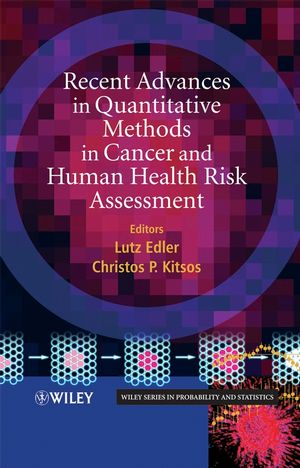Recent Advances in Quantitative Methods in Cancer and Human Health Risk AssessmentISBN: 978-0-470-85756-4
Hardcover
512 pages
May 2005
 |
||||||
Preface.
Introduction.
I CANCER AND HUMAN HEALTH RISK ASSESSMENT.
Introductory remarks.
1. Principles of Cancer Risk Assessment: The Risk Assessment Paradigm (Vincent J. Cogliano).
1.1 The risk assessment paradigm.
1.2 Hazard identification.
1.3 Dose-response assessment.
II BIOLOGICAL ASPECTS OF CARCINOGENESIS.
Introductory remarks.
2. Molecular Epidemiology in Cancer Research (Gerassimos Voutsinas, Anastasia Apostolidou and Natalia Spyrou).
2.1 Introduction.
2.2 From carcinogen exposure to cancer.
2.3 Biomarkers.
2.4 Validation of biomarkers.
2.5 Factors influencing cancer risk.
2.6 New tools in molecular epidemiology.
2.7 Conclusions.
3. Genetic Polymorphisms in Metabolising Enzymes as Lung Cancer Risk Factors (Angela Risch, Heike Dally and Lutz Edler).
3.1 Introduction.
3.2 Methodological aspects.
3.3 Examples.
3.4 Discussion.
Acknowledgements.
4. Biological Carcinogenesis: Theories and Models (Sylvia Solakidi, Constantinos E. Vorgias and Constantine E. Sekeris).
4.1 Introduction.
4.2 Models of human carcinogenesis.
4.3 The multistage mouse skin carcinogenesis model.
4.4 Epilogue.
5. Biological and Mathematical Aspects of Multistage Carcinogenesis (E. Georg Luebeck and Suresh H. Moolgavkar).
5.1 Introduction.
5.2 Features of multistage carcinogenesis.
5.3 Generalized TSCE model.
5.4 Modeling cancer incidence.
5.5 Summary.
6. Risk Assessment and Chemical and Radiation Hormesis: A Short Commentary and Bibliographic Review (Jose J. Amaral Mendes and Eric Pluygers).
6.1 Introduction.
6.2 The concept of hormesis.
6.3 Chemical hormesis.
6.4 Radiation hormesis.
6.5 Concluding remarks.
III MODELING FOR CANCER RISK ASSESSMENT.
Introductory remarks.
7. Modeling Exposure and Target Organ Concentrations (Karen H. Watanabe).
7.1 Introduction.
7.2 Data from molecular biology.
7.3 The next generation of physiological models.
7.4 Discussion and conclusions.
Acknowledgements.
8. Stochastic Carcinogenesis Models (Annette Kopp-Schneider, Iris Burkholder and Jutta Groos).
8.1 Introduction.
8.2 Stochastic models for hepatocarcinogenesis.
8.3 Model-based evaluation of liver focal lesion data.
8.4 Conclusions.
9. A Unified Modeling Approach: From Exposure to Disease Endpoints (Chao W. Chen).
9.1 Background.
9.2 Conventional approach to modeling carcinogenesis.
9.3 State space modeling using sampling techniques.
9.4 Self-organizing algorithm for state space modeling.
9.5 Some examples of state space models.
9.6 A computing procedure for the three-stage model.
9.7 Discussion.
Appendix: Simulation programs.
10. Modeling Lung Cancer Screening (Marek Kimmel, Olga Y. Gorlova and Claudia I. Henschke).
10.1 Introduction.
10.2 Screening and Other Relevant Studies.
10.3 Principles of modeling of lung cancer screening.
10.4 Review of modeling approaches.
10.5 Modeling the impact of new screening modalities on reduction of mortality from lung cancer.
10.6 Comparison of models and concluding remarks.
11. Optimal Regimens of Cancer Screening (Leonid G. Hanin and Lyudmila V. Pavlova).
11.2 Optimal screening.
11.3 Formula for the screening efficiency functional.
11.4 The data and parameter estimation.
11.5 Numerical experiments.
11.6 Discussion.
Acknowledgement.
IV STATISTICAL APPROACHES FOR CARCINOGENESIS STUDIES.
Introductory remarks
12. Analysis of Survival Data with Non-proportional Hazards and Crossings of Survival Functions (Vilijandas B. Bagdonavicˇius and Mikhail S. Nikuline).
12.1 Introduction.
12.2 Models.
12.3 Parametric and semiparametric estimation.
12.4 Goodness-of-fit for the Cox model against the cross-effects models.
12.5 Examples.
12.6 Concluding remarks.
Appendix: Proof of Theorem 12.1.
13. Dose-response Modeling (Lutz Edler, Annette Kopp-Schneider and Harald Heinzl).
13.1 Introduction.
13.2 Elements of the dose-response assessment.
13.3 Dose-response models.
13.4 Dose-response models in risk assessment.
13.5 Dose-Response modeling of 2,3,7,8-tetrachlorodibenzo-p-dioxin.
13.6 Concluding remarks.
14 Benchmark Dose Approach (Fred Parham and Christopher Portier).
14.1 Introduction.
14.2 Use by regulatory agencies.
14.3 Calculation methods.
14.4 Literature survey.
14.5 Software and calculation example.
15. Uncertainty Analysis: The Bayesian Approach (Frédéric Y. Bois and Cheikh T. Diack
15.1 Introduction.
15.2 Representations of uncertainty.
15.3 Causes of uncertainty.
15.4 Types of uncertainty.
15.5 Quantifying uncertainty.
15.6 Reducing uncertainty.
15.7 Conclusion.
Acknowledgements.
16. Optimal Designs for Bioassays in Carcinogenesis (Christos P. Kitsos).
16.1 Introduction.
16.2 On the optimal design theory.
16.3 The Michaelis–Menten model.
16.4 Dose extrapolation designs.
16.4.1 The Weibull model.
16.5 Discussion.
Acknowledgements.
V SPECIFIC MODELING APPROACHES FOR HEALTH RISK ASSESSMENT.
Introductory remarks
17. Cancer Risk Assessment for Mixtures (Christos P. Kitsos and Lutz Edler).
17.1 Introduction.
17.2 Basic principles.
17.3 Design of mixture experiments.
17.4 Discussion.
18. Designs and Models for Mixtures: Assessing Cumulative Risk (James J. Chen, Ralph L. Kodell and Yi-Ju Chen).
18.1 Introduction.
18.2 Experimental designs and models for whole mixture.
18.3 Dose-response modeling for component-based approach.
18.4 Component-based risk assessment for quantitative response data.
18.5 Discussion.
19 Estimating the Natural History of Breast Cancer from Bivariate Data on Age and Tumor Size at Diagnosis (Alexander V. Zorin, Lutz Edler, Leonid G. Hanin and Andrej Y. Yakovlev).
19.1 Introduction.
19.2 The model.
19.3 Estimation of model parameters.
19.4 Data analysis.
Acknowledgements.
VI CASE STUDIES.
Introductory remarks.
20. Statistical Issues in the Search for Biomarkers of Colorectal Cancer Using Microarray Experiments (Byung-Soo Kim, Sunho Lee, Inyoung Kim, Sangcheol Kim, Sun Young Rha and Hyun Cheol Chung).
20.1 Introduction.
20.2 Experiments, data and statistical issues.
20.3 Results.
20.4 Discussion.
Acknowledgements.
21. Optimal Experimental Designs for Prediction of Morbidity after Lung Resection (Jesus F. López Fidalgo, Sandra A. Garcet-Rodr&ıacute;guez and Gonzálo Varela).
21.1 Medical problem.
21.2 Prediction model and advantage of designing the experiment.
21.3 Optimal experimental design approach.
21.4 Solution.
22. Logistic Regression Methods and their Implementation (Vassiliki K. Kotti and Alexandros G. Rigas).
22.1 Introduction.
22.2 Neurophysiological example.
22.3 Logistic regression.
22.4 Neurophysiological example revisited.
22.5 Discussion.
23. The use of Logistic Regression, Discriminant Analysis and Classification Trees in Predicting Persisting Remission in Childhood Leukemia (Malgorzata Ćwiklińska-Jurkowska, Piotr Jurkowski and Andrzej Koltan).
23.1 Introduction.
23.2 Patients.
23.3 Methods.
23.4 Results.
23.5 Discussion.
23.6 Concluding remarks.
24. Non-melanoma Skin and Lung Cancer Incidence in Relation to Arsenic Exposure: 20 Years of Observation (Vladim&ıacute;r Bencko, Petr Franěk, Jiř&ıacute; Rameš, Elenóra Fabiánová and Miloslav Götzl).
24.1 Introduction.
24.2 Material and methods.
24.3 Results.
24.4 Discussion.
24.5 Conclusion.
Acknowledgements.
25. Thyroid Cancer Incidence Rates in Zaragoza (Milagros Bernal).
25.1 Introduction.
25.2 Materials and methods.
25.3 Results.
25.4 Discussion.
References.
Index.



